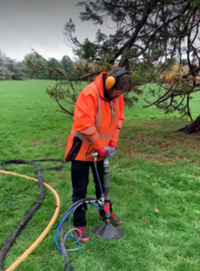This includes members of the grove of Giant Redwood trees (Sequioadendron giganteum) near the North Lodge entrance from Parks Road, which have been the focus of efforts over the last few months to de-compact and fertilise the soil they are growing in.
Most of these were planted in the late 1880s, although the youngest tree in the group dates from almost a century later. That’s just a fraction of how long a healthy sequoia tree should live, but the team are concerned that unsuitable conditions seem to be sapping the strength of at least two of the trees.
In their native habitat in the Western USA, Giant Redwoods can grow into the world’s biggest living organisms – nearly 100m tall and with trunks up to 8m thick. Those that have been brought to other parts of the world are rarely on that scale, but these ones still form a striking group in the corner of the park.
Last year, Parks staff noticed that two of them were showing signs of stress – in the picture below, these are the big trees to the left and right, whose crowns are sparse and starting to die back, with bare branches visible in several places. The tree in the middle, by contrast, still looks vigorous with thick, healthy foliage.
The team think there are probably several causes for this – among them the thin layer of earth in that area, with river gravels beneath which hold little water and few nutrients, and the compacted soil caused by generations of passing people and vehicles, which closes up the natural spaces in the soil and makes it hard for air and water to reach the trees’ roots. The heatwaves Oxford has seen in recent years have made the problem worse, and the two trees in question are now faltering. If something isn’t done, their health is likely to continue deteriorating – and the other sequoias nearby could soon follow.

Arboricultural supervisor Richard Haley using Vogt Geo Injector Pro (North Lodge)
What’s needed is to improve the soil the trees are growing in. At a forestry exhibition last year, Parks staff talked to a company that specialises in doing this, who agreed to perform a free trial of their technology.
So on a rainy day in November, a team from Apex Soil Solutions visited the Parks and used a 65cm-long probe to force compressed air down into the soil around the trees, re-opening the pores in the soil, and then following it by injecting biochar – a mix of crushed charcoal, worm castings, seaweed and the spores of beneficial fungi. This should help the soil breathe and let it hold more water and nutrients, as well as supporting more microbial activity.
Afterwards the team added a 10cm-thick layer of composted mulch beneath the trees, which should let even more water and air into the soil as well as supressing weeds, providing nutrients and encouraging a diverse underground community of living things – for example, as the mulch breaks down, it attracts more earthworms to continue improving the soil.
The Arboricultural team will now monitor the results by testing how efficiently each tree can turn sunlight into energy through photosynthesis every three months – the more inefficient this process becomes, the more stress the tree is under from its environment.
If the trees’ stress levels start to fall compared to measurements taken before work began, that will mean efforts at soil improvement are helping. Parks staff hope this will give the trees many more years of healthy life.
The team have also been working to improve the soil beneath two big cedars in the Nappers Arable area to the north of the Parks that are also thought to be struggling, using lower-tech methods, adding mulch beneath the trees and cordoning the area off to avoid any further soil compaction.